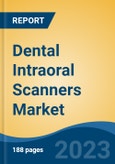Speak directly to the analyst to clarify any post sales queries you may have.
10% Free customizationThis report comes with 10% free customization, enabling you to add data that meets your specific business needs.
With the growing number of patients seeking orthodontic and restorative dental care, especially in regions like the U.S. and Canada, the adoption of intraoral scanners is accelerating. These scanners enhance clinical workflows by offering quicker, cleaner, and more precise imaging using high-speed cameras and light-based technology, enabling digital models that improve diagnostic accuracy and treatment customization. Their compatibility with digital dentistry systems further enhances their value, supporting the dental industry's shift toward efficiency, comfort, and advanced patient care.
Key Market Drivers
Technological Advancements
The rapid pace of technological innovation is a key driver fueling the growth of the Global Dental Intraoral Scanners Market. Modern intraoral scanners are now equipped with high-resolution optics, faster scanning capabilities, and enhanced software integration that streamline the workflow for dental professionals. For example, the launch of the IS 3800 wired scanner by DEXIS IOS Solutions in June 2023 showcased advancements in scanning speed and precision, further improving clinical outcomes.These developments enhance the quality and reliability of digital impressions, which are essential for restorative, orthodontic, and implant procedures. The incorporation of artificial intelligence (AI) and machine learning into scanner software also aids in automating processes such as tooth segmentation, margin identification, and prosthetic design. This improves diagnostic consistency and reduces manual labor. As the adoption of CAD/CAM systems expands in dental practices worldwide, the demand for technologically advanced intraoral scanners is expected to rise, enabling a seamless and fully digital dental care experience.
Key Market Challenges
Product Recalls and Safety Issues
A major challenge to the widespread adoption of dental intraoral scanners is the high initial cost of acquisition and the ongoing maintenance required. Dental clinics - particularly small or independent practices - often face financial limitations that hinder investment in high-tech equipment like intraoral scanners. In addition to the cost of the device itself, there are expenses associated with licensing, staff training, and integrating the scanner with existing practice management software. These costs can deter potential buyers, especially in cost-sensitive regions. Moreover, recurring expenses such as software updates, system calibration, and equipment servicing contribute to the overall cost of ownership, making it less feasible for smaller establishments. As the market continues to grow, addressing these cost-related barriers through flexible financing options, subsidies, or technological advancements that reduce production costs will be essential for broader adoption.Key Market Trends
Digital Dentistry And The Transition From Analog To Digital Workflows
A transformative trend in the dental industry is the shift from traditional analog procedures to digital dentistry workflows, with intraoral scanners playing a central role. These devices replace conventional impression methods with high-precision digital imaging, leading to improved accuracy, reduced chair time, and enhanced patient comfort. Integration with CAD/CAM systems enables the efficient design and production of dental restorations, such as crowns and bridges, reducing turnaround time and elevating treatment quality. The digital nature of intraoral scans also simplifies record-keeping, remote consultations, and collaboration with dental laboratories. As dental professionals increasingly embrace digital solutions for diagnostics and treatment, intraoral scanners are becoming a fundamental component of modern dental practices worldwide, supporting faster, more predictable, and patient-centric care.Key Players Profiled in this Dental Intraoral Scanners Market Report
- Dentsply Sirona Inc
- Align Technology, Inc.
- Medit Corp.
- 3Shape A/S
- Institut Straumann AG
- Carestream Dental LLC
- PLANMECA OY
- Midmark Corporation
- GC EUROPE A.G.
- DURR DENTAL SE
Report Scope:
In this report, the Global Dental Intraoral Scanners Market has been segmented into the following categories, in addition to the industry trends which have also been detailed below:Dental Intraoral Scanners Market, by Modality Type:
- Benchtop
- Standalone
- Wall Mounted
- Portable
Dental Intraoral Scanners Market, by Technology:
- Optical Wand
- Confocal Microscope Imaging
Dental Intraoral Scanners Market, by Application:
- Dental Restoration Orthodontics
- Periodontics
- Endodontics
- Others
Dental Intraoral Scanners Market, by Type:
- Power-Free
- Power-Based
Dental Intraoral Scanners Market, by End User:
- Dental hospitals and clinics
- Dental diagnostic centers
- Dental Academic and Research Institutes
- Others
Dental Intraoral Scanners Market, by Region:
- North America
- United States
- Canada
- Mexico
- Asia-Pacific
- China
- India
- South Korea
- Australia
- Japan
- Europe
- Germany
- France
- United Kingdom
- Spain
- Italy
- South America
- Brazil
- Argentina
- Colombia
- Middle East & Africa
- South Africa
- Saudi Arabia
- UAE
Competitive Landscape
Company Profiles: Detailed analysis of the major companies present in the Global Dental Intraoral Scanners Market.Available Customizations:
With the given market data, the publisher offers customizations according to a company's specific needs. The following customization options are available for the report.Company Information
- Detailed analysis and profiling of additional market players (up to five).
This product will be delivered within 1-3 business days.
Table of Contents
Companies Mentioned
The leading companies profiled in this Dental Intraoral Scanners market report include:- Dentsply Sirona Inc
- Align Technology, Inc.
- Medit Corp.
- 3Shape A/S
- Institut Straumann AG
- Carestream Dental LLC
- PLANMECA OY
- Midmark Corporation
- GC EUROPE A.G.
- DURR DENTAL SE
Table Information
| Report Attribute | Details |
|---|---|
| No. of Pages | 180 |
| Published | May 2025 |
| Forecast Period | 2024 - 2030 |
| Estimated Market Value ( USD | $ 340.82 Million |
| Forecasted Market Value ( USD | $ 517.72 Million |
| Compound Annual Growth Rate | 7.3% |
| Regions Covered | Global |
| No. of Companies Mentioned | 11 |









